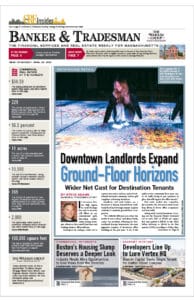Boston is plagued by high housing costs that threaten our prosperity. City leaders are taking a multifaceted approach to address its persistent lack of affordability.
There is a well demonstrated need for new housing in Boston at all income levels in order for our economy to continue to grow. Toward this end, the administration of Boston’s Mayor Martin J. Walsh established a goal of adding 53,000 residences to Boston by 2030.
His administration also took a hard look at the available regulatory and financial tools to see what additional progress could be made. As a result, some high-profile changes were made to the city’s Inclusionary Development Policy (IDP), the purpose of which is to assist with the creation of affordable housing.
These IDP housing units and precious subsidy dollars enable the creation of housing for low and moderate income individuals and families, generally those with incomes pegged at up to 70 percent or 80 percent of the median income in the Boston area.
The mayor made the IDP more ambitious by tweaking the formula to generate more affordable housing, while at the same time incentivizing where new affordable units are built. These changes take advantage of the private market’s huge appetite to create luxury housing in the downtown. Boston has actually done a pretty good job by national standards of creating permanent affordable housing stock, and this is a chance to broaden the impact.
City leaders are particularly interested in targeting the lack of middle-class housing, sometimes called “workforce housing,” which is currently some of the most expensive in the country.
“Today, Boston is facing an unprecedented and growing set of challenges as market forces erode housing options for the middle class,” the Walsh administration’s “Housing a Changing City: Boston 2030” report said. The report defined Boston’s middle class broadly as households with annual incomes between $50,000 and $125,000 (the city’s median income in 2012 was about $53,000).
Creative Thinking At All Levels
To help tackle the challenge of keeping Boston affordable to middle income families, the city created what it calls a Housing Innovation Lab. Connecting this effort through the city’s Office of New Urban Mechanics with staff at both the Boston Redevelopment Authority and the Department of Neighborhood Development, the administration is trying out some promising ideas.
One of the most exciting ones involves the creation of a new “density bonus” policy. This policy would increase the amount of multifamily housing built at scale – creating mid- to high-rise buildings, ideally with commercial or retail uses at the street level. Particularly attractive are those areas of the city near transit that once had a strong commercial or industrial base, but where these uses have declined.
Three areas of the city are currently being studied for this purpose as part of collaborative planning with community members. They include the neighborhoods where Jamaica Plan and Roxbury meet along Washington Street, a section of South Boston along Dorchester Avenue, and Dudley Square. Community discussions are in full swing, and ultimately this planning could provide the framework for decisions about broader rezoning.
Developers usually want to build to the fullest capacity, including increases in height and density. Tradeoffs can make for a better project overall, not only increasing the percentage of affordable units but also in some cases additional open space or community and civic space.
The “density bonus” program has this feature and at a basic level here is how it could work, keeping in mind that certain aspects are being ironed out.
A 100-unit apartment complex would, under usual circumstances, be required to have 13 affordable units. An increase in allowed density or height could be allowed in exchange for a developer’s agreement to build four more affordable units, or a total of 17, with the added units specifically targeting the lack of supply of middle-income housing.
In the case of rental housing, these additional four units would be affordable to families with incomes up to 100 percent of area median income. A two-bedroom apartment would rent for about $2,027 a month, or considerably less than the current market rate. If the units are for sale condominiums, they would be made available to families with incomes up to 120 percent of area median income, and a two bedroom would be priced at about $325,500, also cheaper than what can be found in the neighborhood today.
The density bonus program is a promising idea among others being developed and piloted by the Walsh administration. This is the kind of creative thinking that we need to tackle our housing challenges.
Susan Gittelman is the executive director of B’nai B’rith Housing, a nonprofit, affordable housing developer currently working in Sudbury and Brighton.





